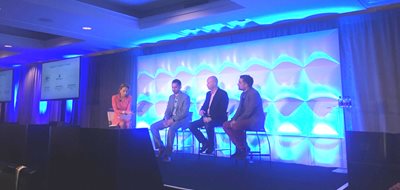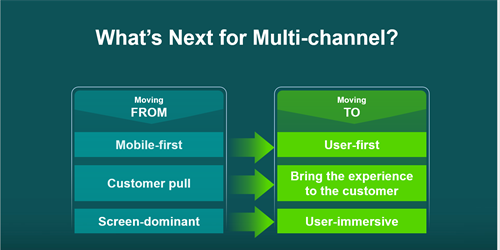Exclusive Interview with Progress CMO Loren Jarrett on DX
By Venus Tamturk and Laura Myers
June 1, 2017
Content Management System, Exclusive Interviews, IoT, marketing technologies, Mobile Content Management, omnichannel, persona, personalization, Progress, Progress Sitefinity, technology, Women in Tech
The technology landscape has been changing at light speed in recent years, so much so that today, we are developing high-end technology to establish a permanent, self-sustaining colony on Mars. Having said that, there is still a specific aspect of the technology industry that should have moved much faster by now. No, I am not talking about flying cars from the Jetsons, I am talking about the inclusion of women within meaningful IT and technology leadership roles because today, women only make up 25 percent of the U.S. technology industry. The percentage is even more depressing when it comes to senior positions. Hence, for us, here at CMS-Connected, it is always delightful and an honor having great conversations with incredible women in the tech industry. With this motivation in mind, at SitefinitySummit 2017, which took place earlier this month in downtown Boston with over 150 partners and customers, my co-worker Laura Myers and I were fortunate enough to chat with this outstanding woman leader; Loren Jarrett, Chief Marketing Officer at Progress.
Before diving into the key takeaways from our educational and entertaining conversation with Loren Jarrett, first, let me give you a little bit of her background. As Chief Marketing Officer at Progress, her main responsibility is driving Progress’ global marketing and strategy, applying her strong strategic, analytical and go-to-market skills to propel new growth for the business. However, Loren has a long history of success in the web content management and digital experience space. Prior to Progress, she was Chief Marketing Officer at Acquia and drove the creation of a predictable and scalable demand generation model, launched new positioning and accelerated Acquia’s leadership position with analysts. As CMO of Kaseya, Loren built a global marketing team focused on digital marketing and high-velocity demand generation. At FatWire, leading both Marketing and Product Management, Loren drove redefinition of the company’s positioning and product direction, doubling the size of the business and leading to a strategic sale to Oracle. Loren holds an MBA from the Harvard Business School and a BA from Yale University.
What is Stopping Personalization from Taking Off?
During the interview, we started off our conversation with asking her the digital vision and strategy for Progress. She said that at Progress, they believe that the digital experience management space will be driven not only by machine learning, which helps organizations thrive in personalization, segmentation, recommendation capabilities, but is also driven by cognitive computing. “Cognitive is going to drive the future of all kinds of experience applications – even in the background,” she said. “Orchestrating everything based on that is really the vision that we have.”
Loren believes that the amount of data extracted both from centers and human behaviors is so massive and represents a tremendous opportunity for organizations to harness personalization. However, in reality, personalization hasn’t truly become mainstream for many organizations even though they are willing to inject personalization into digital experiences that they deliver to their customers. So if the impediment is the lack of neither technology nor desire, then what is stopping personalization from taking off? Loren address this question by speaking from her experiences: “The technology for personalization has been there for over 10 years, and companies have seen the value of personalization since the beginning. They have seen that there is a value in proving content that is more contextually relevant to their customers. So, the challenge isn’t in the technology or desire, but the challenge that I have seen is really just in implementation.” Therefore, she gave advice to those who have found themselves struggling with getting the personalization capabilities implemented. She recommended starting small: “I think, people, start thinking too big but personalization has very wide ranging implications and it can involve stakeholders across the business. So when they think too big, they find it hard to get started. Organizations should build more of a step by step manner. Start small.”
According to Loren, the first step is defining personas – at this point of the process, she also suggests to find a small set of personas. “Don’t boil the ocean. If you told me to define my personas, I would define tons of personas but that’s not the answer. The answer is really starting small,” she noted. From there, she recommends determining what content you want to personalize. To that point, she asks to create “small” use cases. Once your small set of personas and use cases are determined, it is time to measure. If it shows success, then move onto next use cases in order to expand from there.
During the interview, she gave a shout out to Wärtsilä as she feels that the brand is excelling  personalization by embracing these best practices. For those who are not familiar with the case study, Wärtsilä is a global leader in advanced technologies with net sales totalled EUR 4.8 billion in 2016 and complete lifecycle solutions for the marine and energy markets with approximately 18,000 employees and operating in over 200 locations in more than 70 countries around the world. The brand was faced with a complex digital content ecosystem spanning three business units and regional sites for more than 50 locations and languages. They then decided to redesign and relaunch their website. Wärtsilä viewed personalization as the way of the future, so the new website had to give Wärtsilä the ability to tailor web content to users. Therefore, the brand leveraged Sitefinity Digital Experience Cloud (DEC) to personalize user experiences by serving tailored content recommendations based on each action a returning visitor took on the website. As a result, Progress Sitefinity and Wärtsilä claim that since launching the pilot program with Digital Experience Cloud, Wärtsilä has garnered more than 100 highly qualified leads, which has led to numerous quotes and other engagements from both known prospects and unexpected ones. If you want to learn more on how Wärtsilä tackled the content management related issues that they faced, stay tuned as next week, we will publish our exclusive interview with Johan Bäckman, Manager, External Online Channels at Wärtsilä, from SitefinitySummit 2017.
personalization by embracing these best practices. For those who are not familiar with the case study, Wärtsilä is a global leader in advanced technologies with net sales totalled EUR 4.8 billion in 2016 and complete lifecycle solutions for the marine and energy markets with approximately 18,000 employees and operating in over 200 locations in more than 70 countries around the world. The brand was faced with a complex digital content ecosystem spanning three business units and regional sites for more than 50 locations and languages. They then decided to redesign and relaunch their website. Wärtsilä viewed personalization as the way of the future, so the new website had to give Wärtsilä the ability to tailor web content to users. Therefore, the brand leveraged Sitefinity Digital Experience Cloud (DEC) to personalize user experiences by serving tailored content recommendations based on each action a returning visitor took on the website. As a result, Progress Sitefinity and Wärtsilä claim that since launching the pilot program with Digital Experience Cloud, Wärtsilä has garnered more than 100 highly qualified leads, which has led to numerous quotes and other engagements from both known prospects and unexpected ones. If you want to learn more on how Wärtsilä tackled the content management related issues that they faced, stay tuned as next week, we will publish our exclusive interview with Johan Bäckman, Manager, External Online Channels at Wärtsilä, from SitefinitySummit 2017.
Future of Multichannel and Mobile Web
Day 3 kicked off with Loren’s insightful and fun keynote, and during the keynote, she explained the future of multi-channel in detail and summarized all in a slide below illustrating three specific areas where the mobile web experience will shift to.

During our conversation with her, though, she emphasized the second area the most. She sees mobile as one of the today’s most paramount channels and believes that it becomes an extension of how we are able to interact with each other. “Mobile is something more personal and something that is with people all the time thus it comes into many environments with the user. So the ability to use mobile in very interesting ways is really the future,” she said.
Speaking of thinking outside the box, during her keynote, she invited Duke Bobber, Manager of  Digital at Green Bay Packers, to explain to the audience how The Green Bay Packers, a professional American football team based in Green Bay, Wisconsin, competes in the National Football League and utilizes mobile differently to extend the reach of the game beyond the stadium and engage more with their thriving fan base. The football team launched their mobile website by utilizing Sitefinity CMS so the user experience has been enhanced with real-time updates, stats, game highlights and recaps that are dynamically displayed based on a pre-game, live or post-game focus. However, one of the reasons why Laura and I were so impressed by their mobile site is that the site includes a comprehensive directory of official Packers bars and restaurants throughout the United States, tools for fans to connect with each other, and original content about unique Packers fans and bars. So if their fans want to watch Packers game with their fellow fans and stay out of trouble fighting with Chicago Bears fans, they can (just kidding, we all are mature enough to not to hurt each other for a ball game, right?).
Digital at Green Bay Packers, to explain to the audience how The Green Bay Packers, a professional American football team based in Green Bay, Wisconsin, competes in the National Football League and utilizes mobile differently to extend the reach of the game beyond the stadium and engage more with their thriving fan base. The football team launched their mobile website by utilizing Sitefinity CMS so the user experience has been enhanced with real-time updates, stats, game highlights and recaps that are dynamically displayed based on a pre-game, live or post-game focus. However, one of the reasons why Laura and I were so impressed by their mobile site is that the site includes a comprehensive directory of official Packers bars and restaurants throughout the United States, tools for fans to connect with each other, and original content about unique Packers fans and bars. So if their fans want to watch Packers game with their fellow fans and stay out of trouble fighting with Chicago Bears fans, they can (just kidding, we all are mature enough to not to hurt each other for a ball game, right?).
Another interesting use case implemented was entering into the in-stadium contest sponsored by Coca-Cola using the mobile site powered by Sitefinity CMS. The audience were asked to simply enter their seat, section and row numbers from mobile devices for a chance to win prizes. That way, the brand didn’t only engage with the audience in real time but also monetized its app by placing advertising in a targeted way, rather than having ads repulsively popping up from all over the place. As a result of these efforts:
-
Unique visits to site went up 377 percent
-
Pages views went up 37 percent
-
Retention rates went up 18 percent
Moving forward, Bobber and his team plan to take advantage of user-specific personalization features and analytics, and extend those capabilities across all Packers web properties. This is a great way of acknowledging that mobile is a different channel than the traditional web and it has its own unique use cases to build and leverage.
When it comes to other channels and devices such as conversational systems and connected devices, she believes that we will see a revolutionary change in how people interact with computers, therefore she thinks that we should embed those new emerging channels into the process of how we are doing everything. At a very simplistic level, she gave the process of grocery shopping as an example: “The sensor in my fridge will know what food I am running low on so based on all the big data out there about me, my health needs, and my food preferences, the right food will be automatically delivered to my door, at a time convenient for me” she said and even claimed that we will conduct a meaningful conversation with our fridge through voice-activated interface. She also gave an example of a potential conversation: “Hey Loren, you wanted 1% milk last time, but I know that usually, you like whole, so what do you want to do today?” Wouldn’t be amazing to have a sensitive fridge that always puts your needs first?
My POV
“Cognitive-first” was one of the key focus areas in both her presentation and our conversation with Loren. It is really the time for organizations to reimagine their business processes, automate their workflows through context-aware intelligence systems, and have meaningful interactions with their systems in an effort to achieve their business objectives. To do so, as Loren suggested, it is important to have control over your digital transformation by starting small. With the attempt of a “Big Bang”, so many things can go wrong and next thing you know, your team is overwhelmed by the issues. Therefore, phased, slow, and steady roll-outs are not only easy to control but also more effective to drive lucrative quick wins, so the organization can get motivated to go an extra mile in their digital evolution journey.
If you like this piece, stay tuned for our other exclusive interviews from the event. Until then, you can check out our interview with Anton Hristov, Product Strategy & Marketing at Progress, on what issues have been addressed with Progress Sitefinity’s new release as well as what’s in store for the future releases.

Venus Tamturk
Venus is the Media Reporter for CMS-Connected, with one of her tasks to write thorough articles by creating the most up-to-date and engaging content using B2B digital marketing. She enjoys increasing brand equity and conversion through the strategic use of social media channels and integrated media marketing plans.

Laura Myers
A digital business, marketing and social media enthusiast, Laura thrives on asking unique, insightful questions to ignite conversation. At an event or remotely, she enjoys any opportunity to connect with like-minded people in the industry.